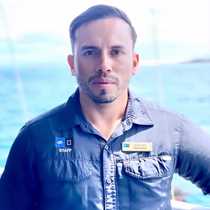Isabela & Fernandina
The western side of this archipelago was calm with a nice breeze early this morning.
Some of us woke up very early to go on a search for marine mammals who are feeding on the abundant food around Isabela Island. We were lucky to spot a pod of bottled nosed dolphins bow riding National Geographic Islander. Our guests were delighted by all the dolphins around the ship and when we thought the action had ended for marine mammals, a pod of about 300 striped dolphins neared our ship. The pre-breakfast marine mammal sightings were just a perfect way to start our day.
We soon got ready after breakfast and went on a Zodiac ride along the coast of Isabela, the largest of all the enchanted islands. During the ride we spotted many blue footed boobies sitting on the tuff cones, as well as noddy terns and brown pelicans. We were surprised by a Galapagos sea lion eating a giant damselfish near a Zodiac; it was interesting to see how it managed to eat the fish on the surface of the wavy ocean. The geology here was fascinating, the brown tuff meeting together with the black lava flows and all this rusty barren area with several Galapagos penguins on the shoreline. This is the third smallest penguin in the world and what I find mostly amazing is the fact that we found sea lions and penguins on the same rock, two two species from completely different hemispheres. The endemic flightless cormorant was also seen nesting along the dry rocky areas of this visitor site known as Punta Vicente Roca. Life was plentiful on land and it was definitely plentiful in the water too, we could see that from the Zodiac. We went snorkeling into a nice protected cove that held plenty of Pacific green sea turtles resting in the bottom and some others on a cleaning station position where fish come to eat the algae off their shells. Penguins, rays and cormorants were also seen in the water.
After lunch, we disembarked on the youngest of the Galapagos Islands, this time at Fernandina Island, a place like no other where we traveled in time to touch a place that had been so untouched by humans. The species here were mostly endemic and some others native to the Galapagos. But life was everywhere; male marine iguanas fighting over territory, flightless cormorants performing their mating rituals, boobies diving for fish, baby sea lions experiencing the shallow waters for the first time while the adults where surfing the big waves off shore. It was just incredible, it seemed like everything was happening at the same time and it was all special. At the same time this makes you think about how successful life is on this young island. This is due to the Cromwell current bathing this side of the archipelago, bringing so much life with it; from plankton which is increasing by the upwelling effects, which affects the rest of the food chain and brings success among species that inhabit this island.




